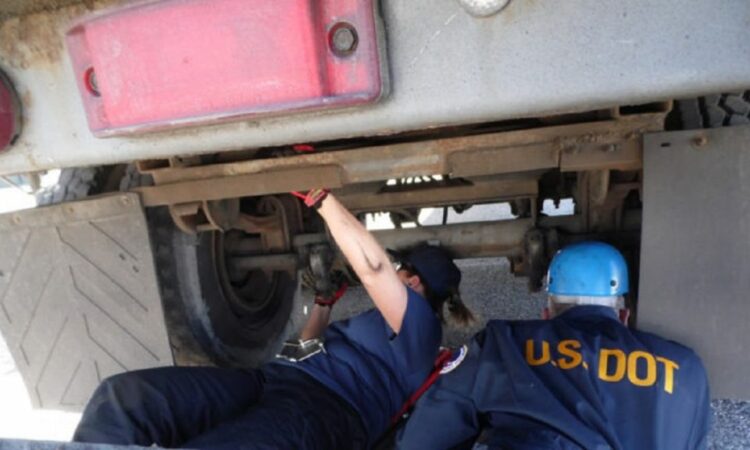Inspectors in Canada, Mexico, and the U.S. conducted 38,117 inspections of commercial motor vehicles during Brake Safety Week from Aug. 21-27.
Of all the commercial motor vehicles inspected, 13.3% were placed out of service for brake-related critical vehicle inspection item violations. The good news is that nearly 87% of the commercial motor vehicles inspected throughout North America during Brake Safety Week did not have brake-related critical vehicle inspection item violations.
The inspections conducted during Brake Safety Week are no different from the inspections conducted any other day of the year. During the week, inspectors compiled and then submitted brake-related data to the Alliance for compilation, analysis, and release.
Fifty-three Canadian and U.S. jurisdictions, and Mexico’s Ministry of Communications and Transportation participated in this year’s Brake Safety Week, a voluntary brake-safety inspection and enforcement initiative.
Broken out by country, inspectors in Canada inspected 1,975 commercial motor vehicles and placed 351 (17.8%) out-of-service for brake-related violations. In Mexico, 1,740 commercial motor vehicles were inspected. Forty-four (2.5%) were placed out of service. In the U.S., of the 34,402 commercial motor vehicles inspected, 4,664 (13.6%) were placed out of service (OOS).
Table 1: Percentage and number of brake-related OOS violations by country
| Country | Number of Inspections | Number of Inspections with OOS Brake Violations | Percentage of Vehicles OOS for Brake Violations |
| Canada | 1,975 | 351 | 17.8% |
| Mexico | 1,740 | 44 | 2.5% |
| U.S. | 34,402 | 4,664 | 13.6% |
| North America | 38,117 | 5,059 | 13.3% |
Also, inspectors identified and documented 6,305 brake hose/tube chafing violations, which are a common brake-related violation and was the focus area for this year’s Brake Safety Week. Inspectors reported brake hose chafing violations in four different categories, varying levels of chafing severity, including out-of-service violations.
Table 2: Percentage of brake hose chafing violations by category and country
| Category | Brake Hose Chafing Violation Descriptions | OOS | Canada | Mexico | U.S. |
| 1 | Wear extends into outer protective material, where applicable. | No | 31% | 34% | 32% |
| 2 | Wear extends through outer protective material into outer rubber cover. | No | 40% | 22% | 36% |
| 3 | Wear makes reinforcement ply visible, but ply is intact. | No | 16% | 29% | 14% |
| 4 | Any part of the fabric/steel braid reinforcement ply is frayed, severed or cut through. | Yes | 12% | 15% | 19% |
In addition, 11 jurisdictions with performance-based brake testers assessed the braking performance of 392 commercial motor vehicles during the enforcement. Twenty-nine commercial motor vehicles failed their PBBT test – a 7% out-of-service rate. PBBTs, based on mechanical or electronic decelerometers, assess the overall vehicle braking capability through a stopping performance test in which deceleration and/or stopping distance is obtained, independent of brake type or application method.
During Brake Safety Week, inspectors primarily conducted the North American Standard Level I or Level V Inspection. Both inspection levels include a thorough examination of brake systems and components. Inspectors will look for missing, non-functioning, loose, cracked, or broken parts, such as spider castings, return springs, brake drums or rotors, brake shoes, linings or pads, and slack adjusters. They also inspect for contaminated linings or pads, non-manufactured holes in spring brake housings, S-cam flip-over, and audible air leaks. They check for mismatched brake chambers on an axle, security of air reservoirs, condition of hoses and lines, air pressure in the system, the breakaway device, tractor protection system, pushrod travel, and brake-system warning devices.
Vehicles that did not have any vehicle and driver out-of-service violations during a Level I or Level V Inspection may have received a CVSA decal, which is a visual indicator (valid for three months) to inspectors that the vehicle was recently inspected and had no critical vehicle inspection item violations.
Next year’s Brake Safety Week is scheduled for Aug. 20-26, 2023.
Brake Safety Week is part of CVSA’s Operation Airbrake program, in partnership with the U.S. Federal Motor Carrier Safety Administration, the Canadian Council of Motor Transport Administrators, and Mexico’s Ministry of Communications and Transportation. Operation Airbrake is a comprehensive program dedicated to improving commercial motor vehicle brake safety throughout North America. The goal is to reduce the number of crashes caused by faulty braking systems on commercial motor vehicles by conducting roadside inspections and educating drivers, mechanics, owner-operators and others on the importance of proper brake inspection, maintenance and operation.


